Did you feel like learning Korean numbers fried your brain already? Well, who doesn’t?
It can be confusing, frustrating, and really confusing. Anybody who learns Korean on their own, or a beginner or traveler, knows that.
But which Korean number system should you use first (and when)?
Is it pure Korean numbers or sino Korean numbers ? Or maybe both?
Let’s change all that here.
In this step-by-step complete guide, you will learn to read any Korean numbers, ordinal numbers, count the time in Korean, explain your age, days of the week , money, easy Korean date format with examples & exercises and more… just like natives do in no time.
Alright friends, Let’s dig in… (to the core)
Table of Contents
What are the Korean Numbers?
Korea uses two number systems: The Sino-Korean Numbers and Native Korean Numbers. The Korean Number System, influenced by the Chinese, is called Sino Korean Numbers. The number system based on the Korean language is called pure/native Korean numbers.
But why does Korea have a Chinese Number system?
Well, it’s a historical thing.
Koreans were using Chinese characters before they even had their own writing system.
And the number system is an example of this.
Why does Korea have two number systems?
Well, it has something to do with Korea’s long history with China and its influence on Korean culture.
Just look at a map and you’ll see that China and Korea are geographically so close.
Besides trading goods to Korea, China also influenced the Korean language and culture in many aspects. In fact, it’s even said that 60% of the Korean language has Chinese origins.
Koreans used Chinese characters before they invented Hangul. Besides, it’s quicker to count large numbers in the Sino-Korean system.
Korea chose to use both number systems for different purposes.
But today we are focused on how to count in Korean with native Korean only
Let’s start with the basic Korean numbers 1–10.
How do count 1 to 10 in native Korean numbers?
For counting native Korean numbers, you only need to know numbers from 1 to 99. Because for bigger numbers, Koreans prefer to use the Sino-Korean number system. Actually, Koreans hardly use native Korean in real-life conversations after 60.
However, bigger numbers in native Korean like 100 or 1000 existed in the past. But not used anymore.
To say native Korean numbers from 1-99, you only need to know 18 numbers. The other numbers are basically the combination of these magic 18 numbers.
Let’s see how to read the Korean Numbers 1 to 10.
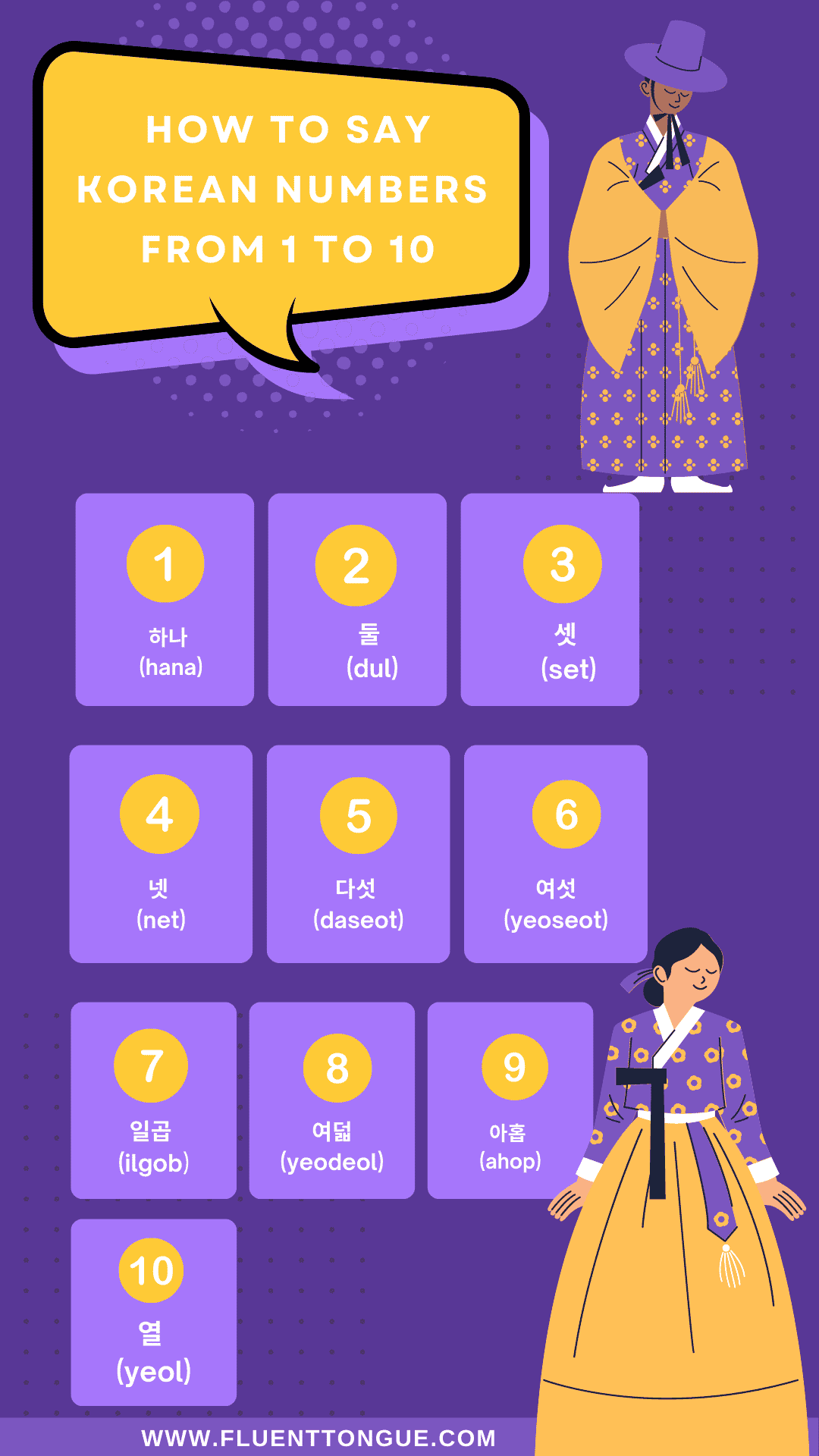
Here’s the complete list of native-Korean Numbers from 1 to 10 with hangul and pronunciations.
- 1 – 하나 (hana)
- 2 – 둘 (dul)
- 3 – 셋 (set)
- 4 – 넷 (net)
- 5 – 다섯 (daseot)
- 6 – 여섯 (yeoseot)
- 7 – 일곱 (ilgob)
- 8 – 여덟 (yeodeol)
- 9 – 아홉 (ahop)
- 10 – 열 (yeol)
Got the Korean numbers 1-10 down?. Great!!
And The rest is easy.
Info box – If you’ve ever seen a Korean person taking a photograph, you’ve probably heard them count to 3 before taking the picture by saying “하나, 둘, 셋“ “hana dul set”.
Sino Korean Numbers 1-10: How To Write Sino Korean Numbers 1 to 10?
Unlike Native Koreans, Sino Korean numbers are really easy to master.
The key to mastering Sino Korean Numbers in 10 minutes is all about knowing 15 numbers only.
Let’s see how.
In order to master Korean, you first need to learn the numbers 1-10. Additionally, you should know the numbers 100, 1000, 10,000, 100 million and 1 trillion. And higher numbers are just combinations of these numbers.
But first, let’s see how to read the Sino Korean numbers 1 to 10.
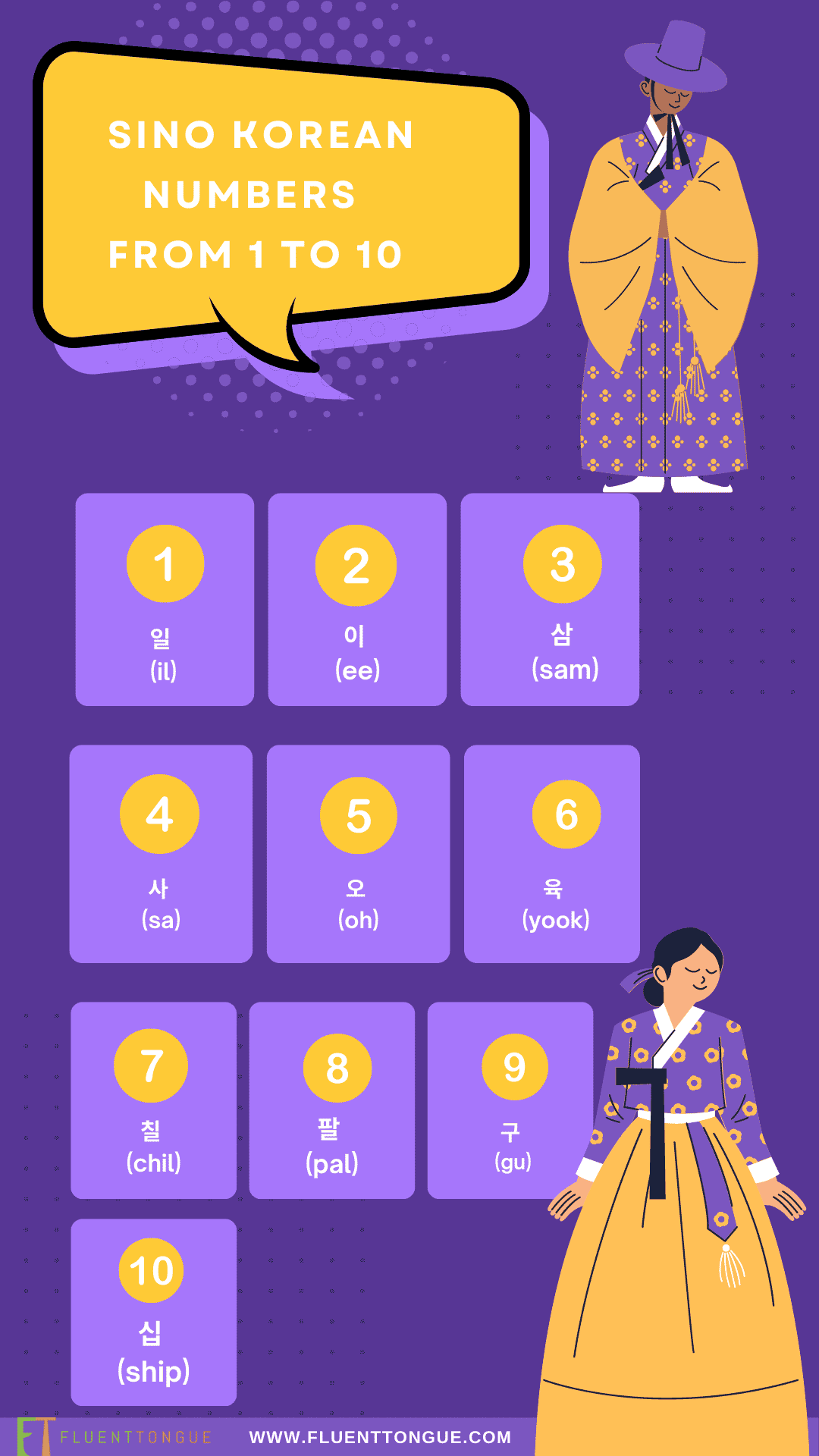
Here’s the complete list of Sino-Korean Numbers from 1 to 10 with zero and pronunciations.
· 0 – 영 (young)
· 1 – 일 (il)
· 2 – 이 (ee)
· 3 – 삼 (sam)
· 4 – 사 (sa)
· 5 – 오 (oh)
· 6 – 육 (yook)
· 7 – 칠 (chil)
· 8 – 팔 (pal)
· 9 – 구 (gu)
· 10 – 십 (ship)
The five more important words:
- 100 – 백(baek)
- 1000 –천 (cheon)
- 10000 –천(man)
- 100 million-억 (Eok)
- 1 trillion – 조 (Jo)
Done with 15 numbers. Well done?
Moving on to counting double digits numbers in Korean
How To Say Sino Korean Numbers 1 to 100.
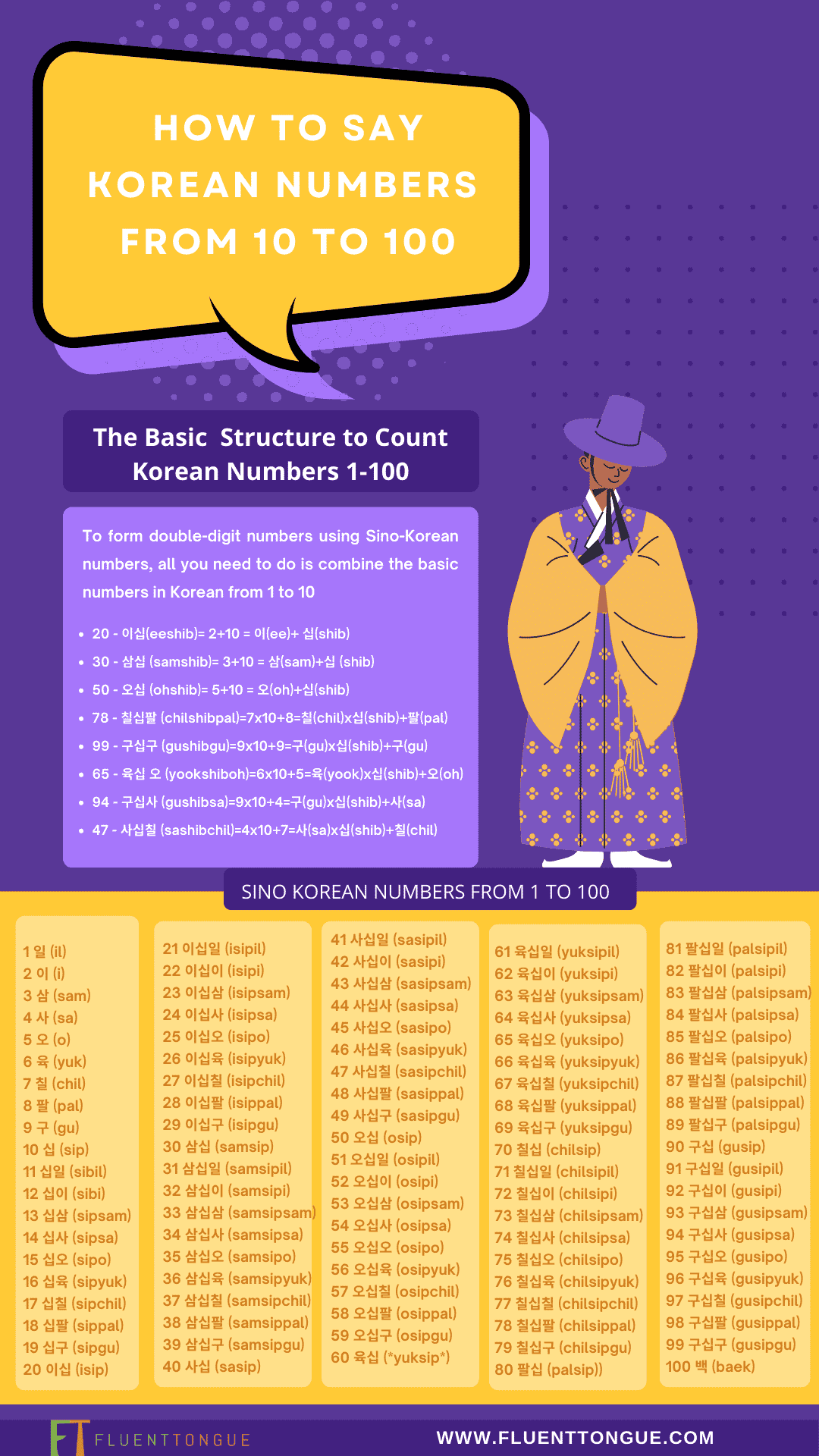
To form double-digit numbers using Sino-Korean numbers, all you need to do is combine the basic numbers in Korean from 1 to 10
Examples
Let’s say number 18. To say 18 in Korean which is shibal, You have to basically say numbers 10 and 8 together in Korean i.e.
- 18 in Korean = 10+ 8=(shib) +(pal)=shipal
- 20 – 이십(eeshib)= 2+10 = 이(ee)+ 십(shib)
- 30 – 삼십 (samshib)= 3+10 = 삼(sam)+십 (shib)
- 50 – 오십 (ohshib)= 5+10 = 오(oh)+십(shib)
so when we want to make 20, we use the words that refer to 2 (이) and 10 (십), but for 38, we add the word that refers to 1 (일) to 20.
38 in Korean =30 +8=3×10+8=samshib+pal
It’s that simple.
· 11 – 십일(shibil) – 10+1= 십(shib)+일(il)
· 33 – 삼십삼 (samshibsam)= 3×10+3=삼(sam)x십(shib)+삼(sam)
· 78 – 칠십팔 (chilshibpal)=7×10+8=칠(chil)x십(shib)+팔(pal)
· 99 – 구십구 (gushibgu)=9×10+9=구(gu)x십(shib)+구(gu)
· 65 – 육십 오 (yookshiboh)=6×10+5=육(yook)x십(shib)+오(oh)
· 94 – 구십사 (gushibsa)=9×10+4=구(gu)x십(shib)+사(sa)
· 47 – 사십칠 (sashibchil)=4×10+7=사(sa)x십(shib)+칠(chil)
· 21 – 이십일(eeshibil)=2×10+1=이(ee)x십(shib)+일(il)
Not that difficult, right?
Korean Culture Fact
Korean Culture Fact
Count native Korean Numbers from 10 to 100.

Just like the Sino-Korean System, to read numbers more than 10 ,we combine the numbers to create the numbers 11-19 and up. In this sense, you can read 11 as “ten one”, 12 as “ten two” and so on.
Let’s start with the tens’ vocab
Unlike Sino-Korean numbers, numbers 20, 30, 40, 50, 60, 70, 80, and 90 have their own special word. Once you learn it, you can then easily say any Native Korean number between 1 and 99.
Here they are
- 10: 열 (yeol)
- 20: 스물 (seumul)
- 30: 서른 (seoreun)
- 40: 마흔 (maheun)
- 50: 쉰 (swin)
- 60: 예순 (yesun)
- 70: 일흔 (ilheun)
- 80: 여든 (yeodeun)
- 90: 아흔 (aheun)
Knowing this, it should be easy. Try to write the numbers 11-19 now.
Info box- What does 4 mean in Korea?
Forming numbers up to 99
Now let’s count the numbers between 10-99 other than the ten’s like 34, 67, 55,21,11,12 etc.
The correct way of reading the native Korean number is to read the tens digits first(10,20,30….)and then say the unit digits and you’re all set!
Let’s say you want to say 21 in Korean which is “스물하나” (seumulhana) which is a combination of 20 in Korean (스물) and 1(하나 in Korean ). Then 12 in Korean would be 열둘[combination of 10(열) and 2(둘 )].
Let me explain by some example
34 – 서른넷( soreunnet)- 30(서른)+4(넷 )
67 – 예순일곱 (yesunilgop)- 60(예순)+7(일곱)
21 – 스물하나 (seumulhana) – 20(스물)+1(하나)
11 – 열하나(yolhana) – 10(열)+1(하나)
33 – 서른셋(soreunset)- 30(서른)+3(셋)
55 – 쉰다섯(swindasot) – 50(쉰)+5(다섯)
99 – 아흔아홉(aheunahop) – 90(아흔)+9(아홉)
82 – 여든둘(yodeundul)- 80(여든)+2(둘)
64 – 예순넷(yesunnet) – 60(예순)+4(넷)
72 – 일흔둘(ilheundul) – 70(일흔)+2(둘)
58 – 쉰여덟(swinnyodol) – 50(쉰)+8(여덟)
46 – 마흔여섯(maheunnyosot) – 40(마흔)+6(여섯)
95 – 아흔다섯(aheundasot) – 90(아흔)+5(다섯)
79 – 일흔아홉(ilheunahop) – 70(일흔)+9(아홉)
Give this a try yourself!
So what’s next?
How to say Sino-Korean Numbers From 100-10,000(3 & 4 digits)
Learning how to say 4 digits Korean numbers is easy if you know three basic words: baek, cheon, and mann. As soon as you learn the numbers from 1 to 10, all you have to do is combine them with baek/cheon/mann!
To learn how to say the numbers in the 100 and 1,000 range, you just have to learn two more words,
To form any number in the 100 and 1,000 range, we use these words, as well as the numbers from 1 to 10. So to say 2350, is
2,350 [이천삼백오십]= 2,000[이천] + 300 [삼백] + 50[오십]
Let me explain with easy examples
200-이백(eebaek)= 2×100=이(ee)+백(baek)
400-사백(sabaek)=4×100=사(sa)+백(baek)
500 – 오백(ohbaek)=5×100=오(oh)+백(baek)
900 – 구백(gubaek)=9×100=구(gu)+백(baek)
2000- 이천(eecheon)=2×1000=이(ee)+천(cheon)
5000-오천(ohcheon)-5×1000=오(oh)+천(cheon)
7000-칠천(chilcheon)= 7×1000=칠(chil)+천(cheon)
9000-구천(gucheon)=9×1000=구(gu)+천(cheon)
Done!
So say you want to say 3,000. You add the 3 (삼) and thousand (천) and then add the 240 (이백사십).
To say a complicated number like 3,301, you first make 3,000 by combining the 3 (삼) and thousand (천).
Here are a few other examples:
- 567 – 오백육십칠(ohbaekyukshibchil) = 5×100 +6×10+7=
- 101 – 백일(baekil)=100+1=
- 240 – 이백사십(eebaeksashib)= 2 x 100+4×10=
- 999 – 구백구십구(gubaekgushibgu) = 9×100+9×10+9=
- 113 – 백십삼(baekshibsam)100+10+3=
- 748 – 칠백사십팔(chilbaeksashibpal)= 7 x 100+4×10+8=
- 119 – 백십구(baekshibgu)=100+10+9=
- 2650 – 이천육백오십(eecheonyukbaekohshib)= 2×1000+6×100+5×10=
- 7280 – 칠천이백팔십(chilcheoneebaekpalshib)= 7×1000+2×100+8×10=
- 3240 – 삼천이백사십(samcheoneebaeksashib)= 3×1000+2×100+4×10=
- 1857 – 천팔백오십칠(cheonpalbaekohshibchil)=1000+8×100+5×10+7=
So you think numbers in Korean are hard now?
It’s only because you’re not practicing it enough!
Let’s give it a try with some real-life examples of how to write dates in Korean.
The Right Way To Count Large Numbers In Korean Using Sino Korean Numbers (10,000 and Up).
Dealing with numbers is one thing, but dealing with big ones can be tricky( especially if you’re not a native speaker)
But You’ll come across these big numbers while talking about money like discussing your salary, rent, or housing prices.
So, it’s time to get those big Korean numbers down!
But first, here’s something interesting
The Korean number system is a little bit different than English. In Korean, the grouping of numbers goes by 10,000 instead of 1,000.
And to read them?
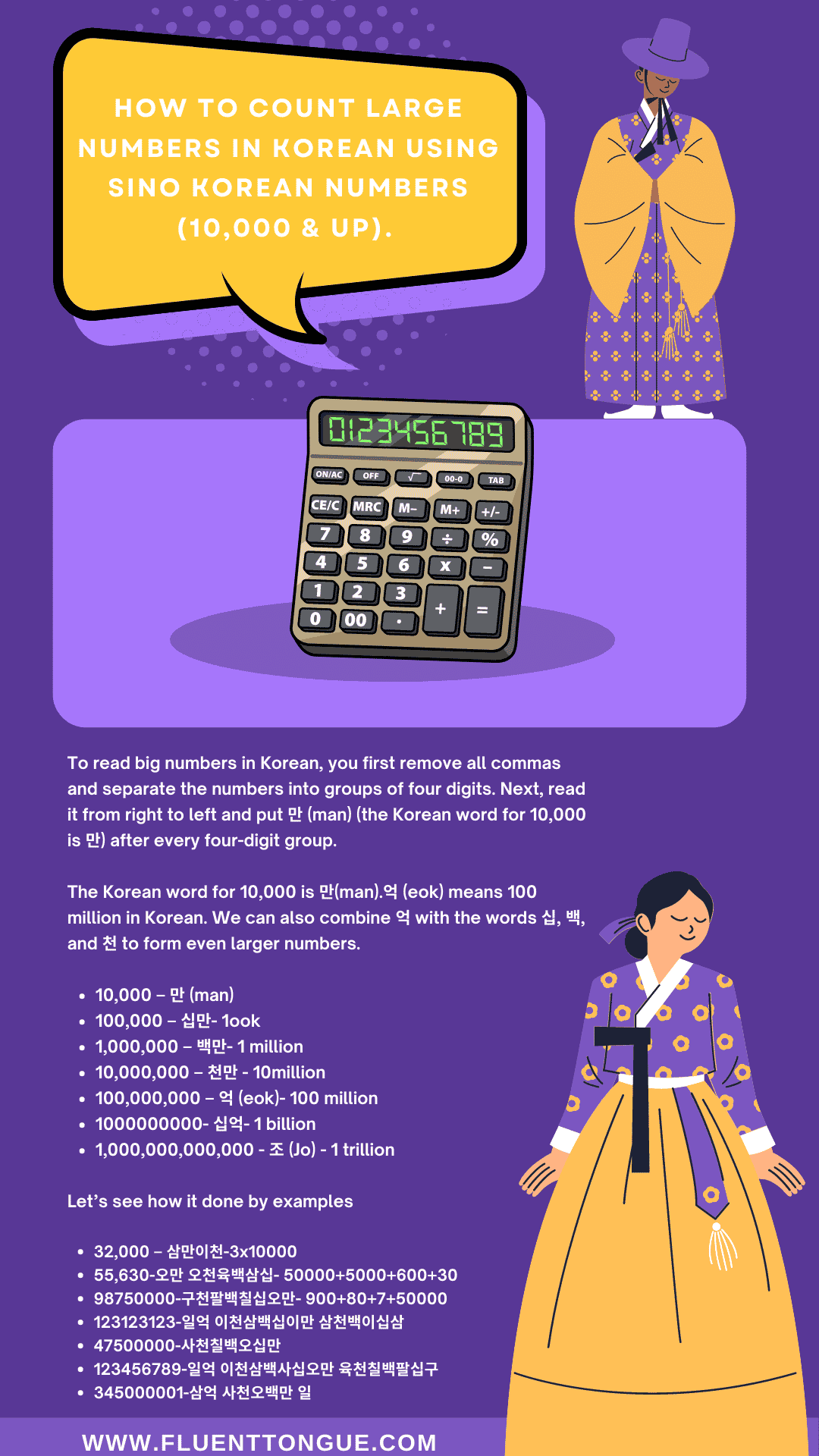
To read big numbers in Korean, you first remove all commas and separate the numbers into groups of four digits. Next, read it from right to left and put 만 (man) (the Korean word for 10,000 is 만) after every four digit group.
The Korean word for 10,000 is 만(man).
• 10,000 – 만 (man)
• 100,000 – 십만- 1 million
• 1,000,000 – 백만
• 10,000,000 – 천만
• 1000000000- 십억- 1 billion
Let’s see how it done by examples
- 32,000 – 삼만이천-3×10000=
- 55,630-오만 오천육백삼십- 50000+5000+600+30
- 98750000-구천팔백칠십오만- 900+80+7+50000=
- 532,100 – 오십삼만이천백=50+32100=50+3×10000+2×1000+100=
- 8,532,150 – 팔백오십삼만이천백오십=
To talk about these bigger numbers millions or billions, the key word is 억 (eok).
- 100,000,000 – 억 (eok)
We can also combine 억 with the words 십, 백, and 천 to form even larger numbers:
Let’s practice telling largest numbers in Korean
- 1,000,000,000 – 십억
- 10,000,000,000 – 백억
- 100,000,000,000 – 천억
- 240,000,000 – 이억사천
- 987650000-구억 팔천칠백육십오만
- 300000000-삼억
- 123123123-일억 이천삼백십이만 삼천백이십삼
- 47500000-사천칠백오십만
- 123456789-일억 이천삼백사십오만 육천칠백팔십구
- 345000001-삼억 사천오백만 일
- 1,240,000,000 – 십이억사천
- 41,240,000,000 – 사백십이억사천
- 23,456,781 is 이천삼백사십오만 육천칠백팔십일
The last one is an extreme example, isn’t it?
You hardly have to say this in real life but you get the idea right?
Okay. enough with big numbers. How about the smallest one?
That’s right, I mean “zero”.
Zero In Korean ( (khong) or 영 (yong)): How To Say Zero In Sino Korean?

Here are the two ways to say zero in Korean language. One is 공 (khong) and the other is 영 (yong) .공 (khong) means “zero” and is used for counting, while the second one영 (yong) ,which means “nothing”.
Info box – Native Korean numbers do not have a word for “zero.” You only say it when counting in Sino
The important thing is knowing when to use yong or khong.
When to Use “영” (yong) as zero in Korean
- When talking about the temperature (O degrees outside).
- When talking about decimal points (0.00013) in math
- When describing points in a game, that you can get or lose. (The game was 7 – 1.)For example, score is “2 – 0”, you would say “이 대 영”
- When referencing the time in a 24-hour clock (00:12 hrs).
When to Use 공 (khong) as zero
When you’re giving your phone number in Korea, you usually start out by saying “공-일-공.”
Got the basics. That’s so great.
But let’s not stop there.
What Are Korean Counters?
Korean has different words to measure things called counters. In order to count things in Korean, we need to use both Korean numbers (Sino-Korean & native Korean numbers) of them.
U can’t just say five people as
Believe it or not, we have counters in the English language too! It’s the same concept as saying “one glass of water” (not, “one water”), or “a pair of pants” (and not, “a pant”).
However, in Korean, this applies to EVERYTHING.
Here’s how to do it
Korean Counters Structure: How To Use Counters In Korean Language?
Counters in Korean are not used alone in Korean sentences.
They always come after the noun and the number of times you want to count an object.
In Korean, Where do counters go in a sentence?
The grammar is simple (with small exceptions, of course)
To count in Korean, all you gotta do is follow this structure.
In Korean: noun + number + counter word.
Step 1: Find the right counter for nouns.
Step2: Fuse with cardinal number/amount after the noun & number
Viola. you are done.
For example
2 people = Korean word for People +two+ counters for people
(i.e. 사람두명[saramdumyong]=[사람] + [두] + [명])
5 horses = Korean word for horse + five + counters for animal
(i.e. 말 다섯 마리[mal dasot mari] = [말] + [다섯] + [마리] )
One book = Korean word for book+ one +counters for book
(i.e. 책 한 권[chaek han gwon] = [책] + [한] + [권]
But What are the dos’ and don’t?
Keep in mind two things.
First, Koreans use native Korean numbers for counting a small number of items. To count a large number of objects you have to use Sino Korean numbers instead.
Secondly, some native Korean numbers (i.e. 1,2,3,4 & 20) have different forms when you use counters.
1 = 하나 –> 한
2 = 둘 –> 두
3 = 셋 –> 세
4 = 넷 –> 네
20 = 스물–>스무
The Basic Structure For Using Counters With Native Korean Numbers
Here is the basic Structure for Using Counters with Native Korean Numbers. When saying how many of something there are, you say the noun, then the Native Korean number, and add the counter word at the end.
Don’t know how native Korean numbers work?
It looks like this
noun + number + counter word
Let me explain with examples
- 7 rabbit = 토끼일곱마리[tokkiilgommari]
- Nine students = 학생아홉명 [hakssaengahommyong]
- 2 o’clock = 두 시[du si]
- 10 bottles=열병[yolbyong]
- 32 books=서른둘권 soreundulgwon
- 6 apples=사과 여섯개 [sagwa yosotkkae]
The Basic Structure For Using Counters With Sino-Korean Numbers
Here is the basic Structure for Using Counters with Sino Korean Numbers. When saying how many of something there are, you say the noun, then the Sino Korean number, and add the counter word at the end.
Don’t know how to count with Sino Korean numbers?
The structure looks like this
noun + number + counter word
For example
- 55,000 won = 오만 오천원 oman ochonwon won
- 7 weeks =7주chil ju
- 13th floor =13층sipssam cheung
- 4 servings =4인분sa inbun
- 6 hours=6시간 yuk sigan
Let’s see in detail what they mean and how to use in Korean sentences
The Ultimate List Of Korean Counters And How Do Koreans Use Counters In A Conversation?
The big problem is that there are too many counters in Korean, enough to make you overwhelmed and it’s hard to figure out which one to use when in a sentence.
So, I made a list of common counters in Korean and divided them based on them with both the Korean number system.
Pure Korean Counters: Learn Different Counters In Korean That Uses Native Korean Numbers

Here is a complete list of the most common Korean counters used with Sino Korean numbers for you to get started!
- To count general things, items: 개 (gae)
- To count the people : 명(myeong)
- To count the animals : 마리 (Mari)
- To count the age in Korean: sal
- To count counter for buildings and houses: 채 (chae)
- To count pair of shoes : 레 (kyeolle)
- To count clothes벌: (beol)
- To count pieces of paper: 장 (jang)
- To count pen and pencils 자루 (jaru).
- To count bottles : 병 (byeong)
- To count cars and machines : 대 (dae)
- To count books and notebooks : 권 (gwon)
Let’s see in detail
개 (Gae) → A General Counter For Things, Items, And Units

If you can’t express a counter for a piece of object in a Korean sentence, there is one absolutely must-know Korean counter in your rescue.
i.e. counter Gae(개). It is a general counter for things, items, and units basically the non-living things.Gae(개) literally means “dog” in Korean.
Why only one?
In a way, it’s magical. If you are lazy, or if you don’t know the correct counter for something while talking, you can just use this and it will (probably) make sense.
Keep in mind most of the time they are used along with native Korean numbers.
Here’s how
Numbers + 개 [gae] (counter for things)
- 1 = 하나 –> 한 개
- 2 = 둘 –> 두 개
- 3 = 셋 –> 세 개
- 4 = 넷 –> 네 개
- 5 = 다섯 –> 다섯 개
- 6 = 여섯 –> 여섯 개
- 7 = 일곱 –> 일곱 개
- 8 = 여덟 –> 여덟 개
- 9 = 아홉 –> 아홉 개
- 10 = 열 –> 열 개
- 11=열한 개,
- 12=열두 개,
- 13=열세 개
- 19=열아홉 개
- 20=스무 개
And so on
Notice how the numbers 1, 2,3,4 & 20 keep coming up to be a pain in the butt?
Let’s take some examples
- one apple = 사과 [sa-gwa] + 1 + 개 [gae] = 사과 한 개 [sa-gwa han gae]
- two stones = 돌 [dol] + 2 + 개 [gae] = 돌 두 개 [dol du gae]
- five balls = 공 [gong] + 5 + 개 [gae] = 공 다섯 개 [gong da-seot gae]
- 12 dolls
- Five pieces of chicken.-치킨이 5개.
- 2 tshirts-티셔츠 2개
- Two pairs of sunglasses-선글라스 2개.
Although the explanation “it can count anything” is pretty right on the money.
For the language learners, it’s better to use incorrect ones and get feedback than not at all
명(Myeong) → A Counter Used For People

The counter 사람 [sa-ram] is used to count people. 사람 by itself means person/people, basically referring to a small number of people.
Usually, for counting the number of people you can use counter 명[myeong]. That covers most of its use
but Korean use 분can actually count seven different categories of things, which we broke down in great detail
To count people all you need to do is
Noun +no of people +명[myeong]
For example
one person = 한 명 [han myeong]
12 students=학생열둘명[hakssaengyoldulmyong]= 학생 [hak-saeng] + 12[ 열둘]+ 명 [myeong]
three friends = 친구 세 명 [chin-gu se myeong] =친구 [chin-gu] + 3 + 명 [myeong]
40 people= 마흔명/사십명[maheunmyongsasimmyong]= 마흔[maheun] + 명 [myeong]
So to say 50 people, you could either say 오십명, or 쉰 명 if you’d like. And to say 100 people, it’s just 백 명.
Example sentences
- How many people are there?
- 몇 명 있어요? [myeot myeong i-sseo-yo?]
- There are 7 people.
- 일곱명 있어요. ilgommyong issoyo
- why you draw 3 people?
- 왜 3명이나 생겼어요?
- Did our manager kill 4 people?
- 매니저가 4명을 죽였나요?-maenijoga sa myongeul jugyonnayo
- I think about 4 people are our fans.
- 4분 정도가 저희 팬인 것 같습니다.
마리 (Mari) :Learn The Korean Counter For Animals?

The main thing that 마리 [mari] does is count animals in Korean.
If you can pick up small or large-sized animals the animal, fish up, you can probably count it with 마리 [mari]
However, counting couples (For people & animals) change is the more common counter.
마리 (Mari) is the Korean counter for animals. To count animals in Korean, all you need to do is say the animal’s name followed by the number of animals you want to count and then add 마리 [mari] at the end.
The basic structure look like this
Noun +number of animals + 마리 [mari]
Let’s take some examples
- one dog = 개 한 마리(gae han mari)=개 [hak-saeng] +한[1] + 마리 [mari]
- two frogs = 개구리 두 마리(gaeguri du mari)= 개구리 [gaeguri] + 2[두] + 마리 [mari]
- three rabbit = 토끼 세 마리[tokki se mari]= 토끼 [tokki] + 3[세] + 마리 [mari]
- 11 sheep=양열 열하나마리(yangnyol yolhanamari)=양[yang] +11[열하나]+ 마리 [mari]
- 42 cats=고양이 사십이 마리(goyangi sasibi mari) =고양이[goyangi ]+ 42[사십이] +마리 [mari]
- 8 birds-새여덟마리[sae yodol mari]
- 17 wolves=늑대 열일곱 마리[neukttae yorilgop mari]
Example sentences
- Do you raise a pet?
애완동물 키워요?-Aewandongmool kiwoyo?
- I raise one dog and two rabbits.
개 한 마리 하고 토끼 두 마리 키워요.- gae han mari hago tokki du mari kiwoyo
- Do you have a pet?
애완동물이 있나요? – aewandongmuri innayo
- No, I don’t have but I want to adopt a cat.
없어요, 하지만 고양이를 입양하고 싶어요.
opssoyo hajiman goyangireul ibyanghago sipoyo
- I have three dogs at home.
저희 집에 강아지가 세마리 있어요.johi jibe gangajiga semari issoyo
- I saw two wolves and one fox in the forest
숲에서 늑대 두 마리와 여우 한 마리를 봤어요.
supeso neukttae du mariwa you han marireul bwassoyo
If you want to know how to pronounce animal names in Korean. Here is a complete list of animals in Korean you can check out before you want to count them.
Test yourself with this Korean vocabulary quiz
Before we go further, practice translating these examples. The answers are at the bottom.
- 5 elephant
- 13 snakes
- 25 birds
- 11 ants
Answers: 1.코끼리 다섯 마리,(kokkiri dasot mari) 2. 뱀 열셋 마리(baem yolset mari) 3. 새 스물다섯 마리(sae seumuldasot mari), 4. 개미 열하나 마리(gaemi yolhana mari)
Korean Age: How To Calculate And Talk About It

Age is so important in Korea. In fact, Koreans exchange their age information at the very first meeting?
Because Age determines whether you will talk to other parties in informal or formal language.
You could accidentally offend people if you are not careful! So it’s crucial to know to count age in Korean before you even land in Korea.
To count age in Korean, all you need to do is add the native Korean number plus 살 (sal), the word for “year(s) old”.
Age in Native Korean number + 살 (sal)
Don’t know how to calculate your age in Korean?
wondering How to Count Age in Korean? here’s a complete guide on all about the Korean age system and how to say your age in Korean like natives with examples.
Let’s take some examples
- 31 years – 서른하나[soreunhana] + 살 (sal)=서른하나살[soreunhanasal]
- 18 years – 열여덟 + 살 (sal)
- 21 years – 스물하나+ 살 (sal)
- 25 years – 스물다섯+ 살 (sal)
- 30 years – 서른+ 살 (sal)
- 29 years – 스물아홉+ 살 (sal)
- 32 years – 서른둘+ 살 (sal)
- 100 years – 백+ 살 (sal)
- 50 years old-쉰 살swin sal+ 살 (sal)
Example
- How old are you?
- 몇 살이세요?- myot sariseyo
- I am 28 years old.
- 저는 스물여덟 살이세요- joneun seumulryodol sariseyo
- I have done it since I was 18 years old.
- 전 18살부터 했습니다.
- I am 31 years old and live in Seoul.
- 저는 서울 사는 31세 하나에요.
- I’m actually not 28 years old. I m 20 years old
- 사실 18살이 아닙니다.20살이에요!
- When we first met him, wasn’t he 18 years old?
- 연준이 형 처음 봤을 때 18살 아니었어요?
- “Hello, guys! I’m Yoon Jin. I’m 18 years old.”
- 안녕하세요, 저는 낭랑 18세 여고생 윤진이에요.’
- I wish I was 21 years old forever.
- 이제 21살이 된 게 너무 신기하다.
Practice
Before we go further, practice translating these examples. The answers are at the bottom.
- 25 years-
- 33 year –
- 27 years –
- 11 years –
- 99 years –
Answers: 1. 스물다섯살,2. 서른셋 살, 3.스물일곱 살, 4.열하나 살,5. 아흔아홉 살
Korean Counter For Buildings: 채 (Chae) → A Counter For Houses And Buildings

To count animals all you need to do is write the numbers in native Korean numbers and add the word 채 (chae). 채 (chae) is a counter for houses and buildings
number + 채 (chae)
Here are some example
- 7 houses =일곱채[ilgopchae] = 일곱 [[ilgop] + 건물(konmul)
- 17 houses = 이열일곱 채 [iyorilgop chae]= 열일곱[iyorilgop ]+ 채 (chae)
Example
- This building has 4 houses
- 이 건물에는 집이 4채 있다.-i gonmureneun jibi sa chae ittta
Korean Counter For Shoes켤레 (Kyeolle) → A Counter For Pairs Of Shoe

켤레 (kyeolle) is a counterword for shoes in Korean. To count shoes, all you need to do is add the Korean word for shoes which is sinbal and then add numbers of shoes(in pairs) and then add the counter 켤레 (kyeolle) at the end.
The structure looks like this
Noun +number of shoes pair + 켤레 (kyeolle)
Let’s see some examples
- Seven pair of shoes =신발[sinbal] + 일곱[ilgop] + 켤레 (kyeolle) = 신발일곱켤레[sinbarilgopkyolre]
- 2 pair of shoes= 신발 두 켤레[sinbal du kyolre]=신발[sinbal] +두[du]+ 켤레 (kyeolle)
- three pair of shoes = 신발[sinbal] + 셋[net] + 켤레 (kyeolle) =sinbalnekyolre
Example sentences
- Did you order 3 pairs of shoes?
신발 세 켤레 주문하셨나요?-sinbal se kyolre jumunhasyonnayo
- I have 6 pairs of shoes as well.
나는 신발도 여섯 켤레가 있어.-naneun sinbaldo yosot kyolrega isso
- I have 2 pairs of Adidas shoes and 8 pairs of Lego shoes!
저는 아디다스 신발 2켤레와 레고 신발 8켤레가 있어요!-joneun adidaseu sinbal i kyolrewa rego sinbal pal kyolrega issoyo
Korean Counter For Paper: 장 (Jang) → A Counter Used For Pieces Of Papers

장 (jang) is a counter used to count pieces of paper. To count papers in Korean, all you need to do is number of papers and add the word at the end.
The basic structure looks like this
number of papers + 장 (jang)
As in
21 sheet of paper = 스물하나 장 [seumulhana jang]= 스물하나[seumulhan] + 장 (jang)
12 sheets of papers=열둘 장 [yoldul jang]= 열둘 [hak-saeng] + 장 (jang)
Example sentences
- I need 5 sheet of paper
종이 5장이 필요합니다.-jongi o jangi piryohamnida
- There are 5 sheet of paper on the table
탁자 위에 종이가 다섯 장 있다.-takjja wie jongiga dasot jang ittta
- There are four pieces of paper.
이렇게 4개의 쪽지가 있어요.
- Didn’t you pick two pieces of paper?
2장 뽑지 않았어요?
Korean Counter For Pencil: Counter For Pens/Pencils Is 자루 (Jaru).How Do You Count Pencils In Korean?

자루[Jaru] is the counter to counting pencils in Korean. To count pencils in Korean, all you have to do is followed by the number of pencils and add the word자루[Jaru] at the end.
The basic Structure looks like this
Noun +number of animals + 자루[Jaru]
4 pencils = 연필 낫자루[yonpil netjjaru] = 연필[yonpil]+ 넷 [net] + 자루[Jaru]
6 pencil- 연필여섯자루[yonpiryosotjjaru]= 연필[ yonpil]+ 여섯+ 자루
25 pencils =연필[yonpil]+스물다섯[seumuldasot][+ 자루[Jaru]= 연필스물다섯자루[yonpilseumuldasotjjaru]
Example
- Please give me 6 pencils
연필 여섯 자루 주세요.-yonpil yosot jaru juseyo
- There are 45 pencils on the table
혹시 연필 같은 거 있으세요?
병 (Byeong) → A Counter For Bottles

To count the number of bottles, you need to use the word 병 (byeong). Just say the numbers of bottles in the native Korean number system and add 병 (byeong) at the end.
number of bottles +병 (byeong)
For example
one bottle= 한 병 [han byeong]= 한[han]+ 병 (byeong)
two bottles = 두병[dubyeong]= 두[du]+ 병 (byeong)
27 bottles = 스물일곱[seumurilgop]+ 병 (byeong)
=스물일곱병[seumurilgopppyong]
Example sentences
- Shall I open another bottle?
한 병 더 딸까요?
- please give me 5 milk bottles
우유 5병 주세요- uyu o byong juseyo
- He drank a whole bottle of wine.
그는 포도주 한 병을 다 마셨다.- geuneun podoju han byongeul da masyottta
- There are 5 water bottles here.
물병이 5개 있습니다.
대 (Dae) → A Counter For Cars And Machines

To count cars in Korean, you can use the counter word대 (dae). All you need to do is add the Korean word for car followed by number of cars you want to count and then add the word 대 (dae).
Noun +number of cars + 대 (dae)
example
- 3 cars = 자동차세대[jadongcha se dae]= 자동차 [hak-saeng] + 세 + 대 (dae)
- 23 cars = 자동차스물셋대[ jadongchaseumulsetttae] = 자동차 [hak-saeng] + 스물셋 + 대 (dae)
Example sentences
- I have 3 cars
저는 차가 3대 있어요.-joneun chaga sam dae issoyo
- i bought two cars yesterday
나는 어제 차 두 대를 샀다.- naneun oje cha du daereul sattta
Learn Korean Counter For Books And Notebooks: 권 (Gwon)

To count animals all you need to do is say books in Korean and add the counter 권 [gwon] after the number of books and notebooks.
The basic structure looks like this
Noun + number of books + 권 [gwon]
Let’s take some examples
Five books =책 다섯 권 [chaek dasot gwon]= 책[chaek]+ 다섯[dasot]+권[gwon]
two notebooks = 공책 두 권 [gongchaekdugwon]=공책 [gongchaek]+두[du]+ 권 [gwon]
Example sentences
- I brought five books.
저는 책 다섯 권을 가져왔어요.-joneun chaek dasot gwoneul gajowassoyo
- There are two books. I’ll recommend it to you.
두 권 있어요 제가 추천해드릴게요.
- I will bring two notebooks tomorrow.
내일 공책 두 권을 가지고 올게요.- naeil gongchaek du gwoneul gajigo olkkeyo
- They only gave me three books.
3권밖에 안 주는 거예요.
Practice
Before we go further, practice translating these examples. The answers are at the bottom.
- 45 books
- 99 notebooks
- 53 cars
- 14 bottles
Answers: 1. 책 마흔다섯 권,2.공책 아흔아홉 권, 3.자동차쉰셋대, 4.열넷 병
Learn All Korean Counters that Uses Sino Korean Numbers
Here is a complete list of the most common Korean counters used with Sino Korean numbers for you to get started!
- To count the months:
- To talk about money:
- To talk about phone numbers:
- Fahrenheit/Celsius in the Korean
- To count the floors of a building
- To tell time in Korean (hours)
- flight /Bus/subway numbers in Korean
Let’s see in detail
How To Talk About Money In Korean : Count Korean Currency

The currency of South Korea is 원 (won), and this is represented by the symbol ₩
In order to count money in, you need to remember three words i.e. 천 means a thousand, and 만 means ten thousand.
For example, if you want to say 5 thousand won, you can say like 오천 원 (three thousand won) in words or ₩5,000 with the symbol.
Here is the basic structure for counting money in Korean. All you have to do is to use enter the amount of money in Sino-Korean numbers, then say the word 천(for thousand)/ 만(for 10,000) and add won(원) at the end.
Sino Korean Number + 천 + 원
For example
- ₩ 1,000 close to $1= 천 원,
- ₩ 2,000 close to $2= 이천 원,
- ₩ 3,000 = 삼천 원
- ₩8500=팔천오백원
- ₩4700=사천칠백원
- ₩1230=천이백삼십원
- ₩2650=이천육백오십원
- ₩1100=천백원
- ₩9999=구천구백구십구원
Note that While talking about ₩ 1,000, you can just say “천 원” directly instead of 일천 원.
Sino Korea Number + 만 + 원
- ₩ 10,000 close to $10 = *만 원,
- ₩ 20,000, close to $20 = 이만 원,
- ₩ 30,000 = 삼만 원
- ₩40,500=사만 오백원
- ₩100000=십만원
- ₩100700=십만 칠백원
- ₩123000=십이만 삼천원
- ₩250000=이십오만원
- ₩255200=이십오만 오천이백원
When you count amount like ₩ 10,000, just say “만 원” directly instead of 일만 원.
Example sentences
- Is that 25,000 won?
이만 오천원 인가?- iman ochonwon inga
얼마에요? – 이만 오백 원이요.-olmaeyo iman obaek woniyo
- How much is it? – 20,500 won.
- How much is this concealer? 6,000 won.
이 컨실러 얼마냐면요. 육천원.- i konsilro olmanyamyonnyo yukchonwon .
- I bought this for 50000 Won at Daiso.
저는 이거 Daiso에서 오만원에 구입했어요.-joneun igo daisso eso omanwone guipaessoyo
- You want 6,000 won worth of walnut cookies?
호두과자 육천원어치 달라고요?-hodugwaja yukchonwonochi dalragoyo
- I earned 9,00000 won this year
저는 올해 900,000 원을 벌었습니다.-joneun olhae gubaek gonggonggong woneul borotsseumnida
월 [Wol]: How To Count The Months In Korean?

In Korean, 한 월 [han wol] is the word for “month”, so you can simply add it after any Sino-Korean number to make a word.
[ month number] + 월 [wol]
Check out the above image for reference, because I’ve listed all the months for you.(in case you forgot what month it was!)
- 월 (일월) = January
- 2월 (이월) = February
- 3월 (삼월) = March
- 4월 (사월) = April
- 5월 (오월) = May
- 6월 (유월) = June*
- 7월 (칠월) = July
- 8월 (팔월) = August
- 9월 (구월) = September
- 10월 (시월) = October*
- 11월 (십일월) = November
- 12월 (십이월) = December
Wow! Did you know that June and October are not following the pattern?
The real reason is simple. “육월” and “십월” are a little difficult to say.
Now that months are done, it’s time for floors
How To Count The Number Of Floors /How To Count Floor In Korean
Here’s a little Korean counting lesson for you.
Here is how to count your floors in Korean. just use Sino-Korean numbers and add the counter충 at the end.
The first floor is 일 충, the second floor is 이 충, and so on and so forth. The fifth floor in Korea is 구(오) 충 because four is thought to be an unlucky number.
How to count floors in Korean:
- First floor: 일 충
- Second floor: 이충
- Third floor: 삼충
- Fourth floor: No such thing!
And now you know how to say count floors in Korean, so it’s time to go have some fun with your new knowledge
Example
- It’s still on the 10th floor.
계속십층에 있어요.-gyesokssipcheunge issoyo
- Should I go to the 2nd floor?
이층으로 가야 되나?
- There’s no 4th floor here.
여기 사층은 없어요.-yogi sacheungeun opssoyo
- The lounge. It’s on the 2nd floor.
휴게실. 계속 2층에 있어요.-hyugesil gyesok i cheunge issoyo
- Shall we go to the 5th floor? Yesung, let’s go.
오층으로 올라갈까요? 가자-ocheungeuro olragalkkayo gaja
How To Tell Time In Korean(Minutes And Seconds ) Using Counter
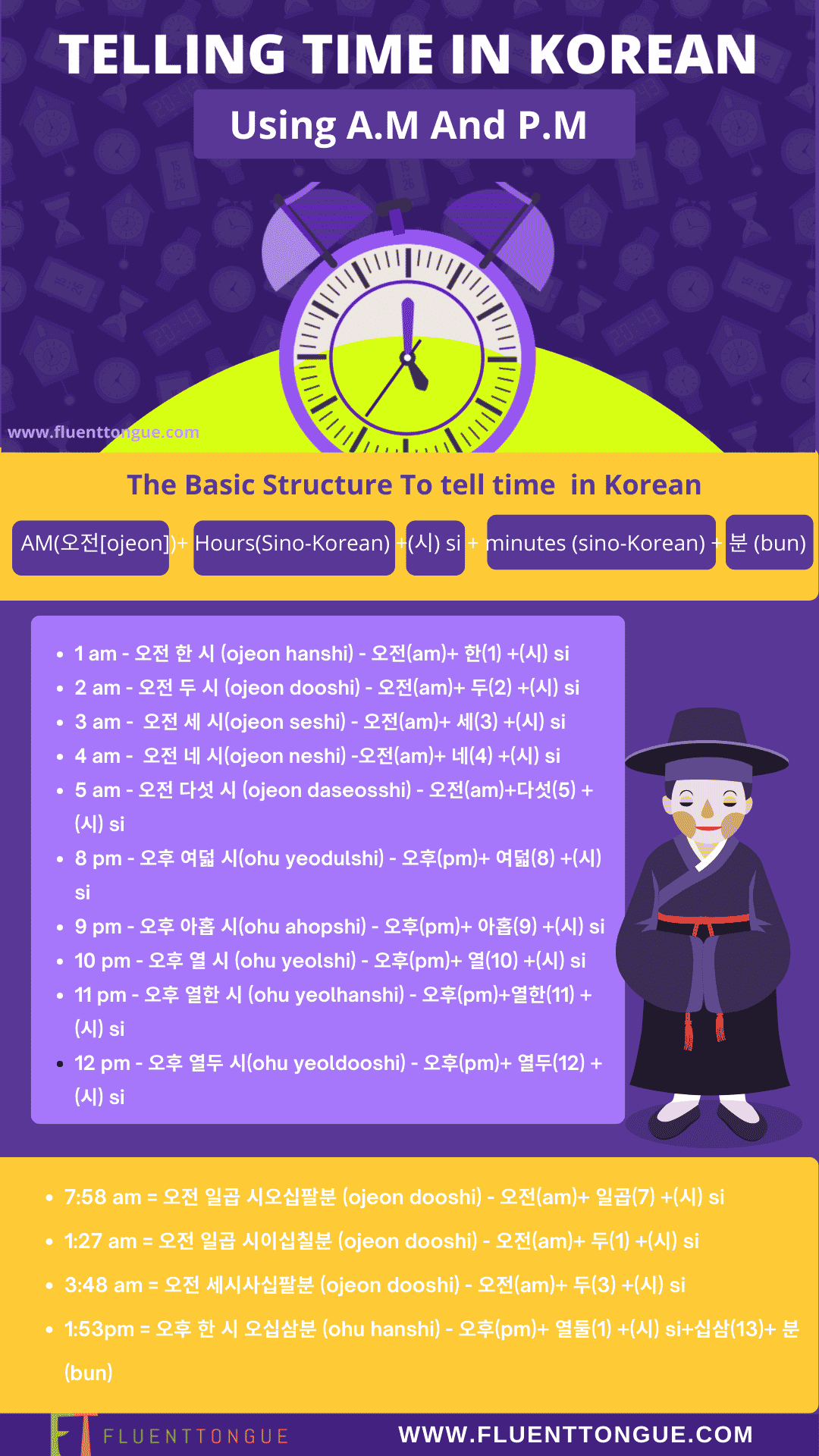
It’s finally time to learn How to tell the time in Korean. So you don’t have to be like me and ask your friends for help.
but it would be helpful if you knew both Sino-Korean and Native-Korean numbers.
I know, It’s a bit tricky but you’ll catch on quickly.
The best way to tell time in Korean is to use Native Korean numbers and add 시 (shi), which means “hour.” And then add Sino-Korean numbers followed by (bun), which means “minute.”
The basic structure to tell time in Korean is like this
Native Korean numbers + 시 (shi)+ Sino Korean numbers + bun
Let’s see some examples
Example
Q: How many people are there?
A: There are 10 people.
6시 맞죠?
It’s 6 o’clock, right?
6시에 나왔죠 오늘?
I came out at 6 o’clock today, right?
6시인데 왜 안 주무세요?
It’s 6 o’clock! Why aren’t you sleeping?
여섯시에 시작했는데 다섯 시간 걸렸네요.
I started at 6 o’clock. It took five hours.
저 어제… 새벽 5시에 잤어요.
I went to bed at 5am.
저 어제 보다가 저도 7시에 잤어요.
I went to bed at 7 AM yesterday watching the drama.
9시에 잤는데도 졸려요. – 잠은 잘수록 녈요.
I went to bed at 9 but I’m sleepy. – The more you sleep, the more you feel sleepy.
저 새벽 6시에 일어나요. – 그러니까, 5시에 자잖아요. – 네?
I woke up at 6 am. – Yes, because you go to bed at 5. – What?
10시에 자서 8시에 일어…
Go to bed at 10. Get up at 8.
Practice
Before we go further, practice translating these examples. The answers are at the bottom.
- 1 person
- 3 people
- 6 people
- 10 people
Answers: 한 명, 세 명, 여섯 명, 열 명
How To Say Fahrenheit/Celsius In The Korean Language?

Ever wondered what Fahrenheit and Celsius are in Korean?
Well, now you’ll never have to.
Koreans operate on the Celsius system (섭씨). The word Fahrenheit (화씨) is also used but not in a formal setting.
Here’s how to say any temperature in Korean. All you need to do is to say just say the number (sino-Korean) and add the word “도”(the counter for degree) at the end.
- 23 degree -23도-isipssam do
- 30degree-삼십
- 45degree celsius-사십오
- 40 degrees Celsius-40도
- 100 degrees Celsius -100도(baek du)
- – 15 degrees Celsius-영하 15도
- -3 degrees Celsius – 영하 3도
- -37 degree celsius- 영하 37도yongha samsipchil do
Example sentences
- Was it 15 degrees Celsius yesterday?
아 어제 십오도였대요?-a oje sibodoyotttaeyo
- I think it’s minus 10 degrees today.
오늘 영하 십일 도인 것 같은데.-oneul yongha simnil doin got gateunde
- It went up to 32 degrees Celsius even in Jeju island.
제주도도 삼십이도까지 올라갔대요.-jejudodo samsibidokkaji olragatttaeyo
- My fever went up to 42 Celsius degrees.
열이 사십이도까지 올랐어요.-yori sasibidokkaji olrassoyo
How To Read Flight /Bus/Subway Numbers In Korean
Here is how you can say flight/bus/ subway numbers in Korean
- 102 number bus is 백이 번 버스
- 4 호선 is line number 4 (Train line)
- 714 열차 is train number 714
- 2 호 차 is car number 2(train car number)
- Flight numbers in Korean -KE121 is KE 북이십일
Example sentences
- You can take bus number 3412 and 6411.
3412번을 타고 오시면 되고, 6411번을 타고 오시면 돼요.
- Number 2, bus.
2번. 버스.
- Did you bring your car? – The car number is 0801.
차 안 가져왔어요? – 저 0801이요
- Number 4, train!
4번. 기차!
How To Tell Your Phone Number In Korean?
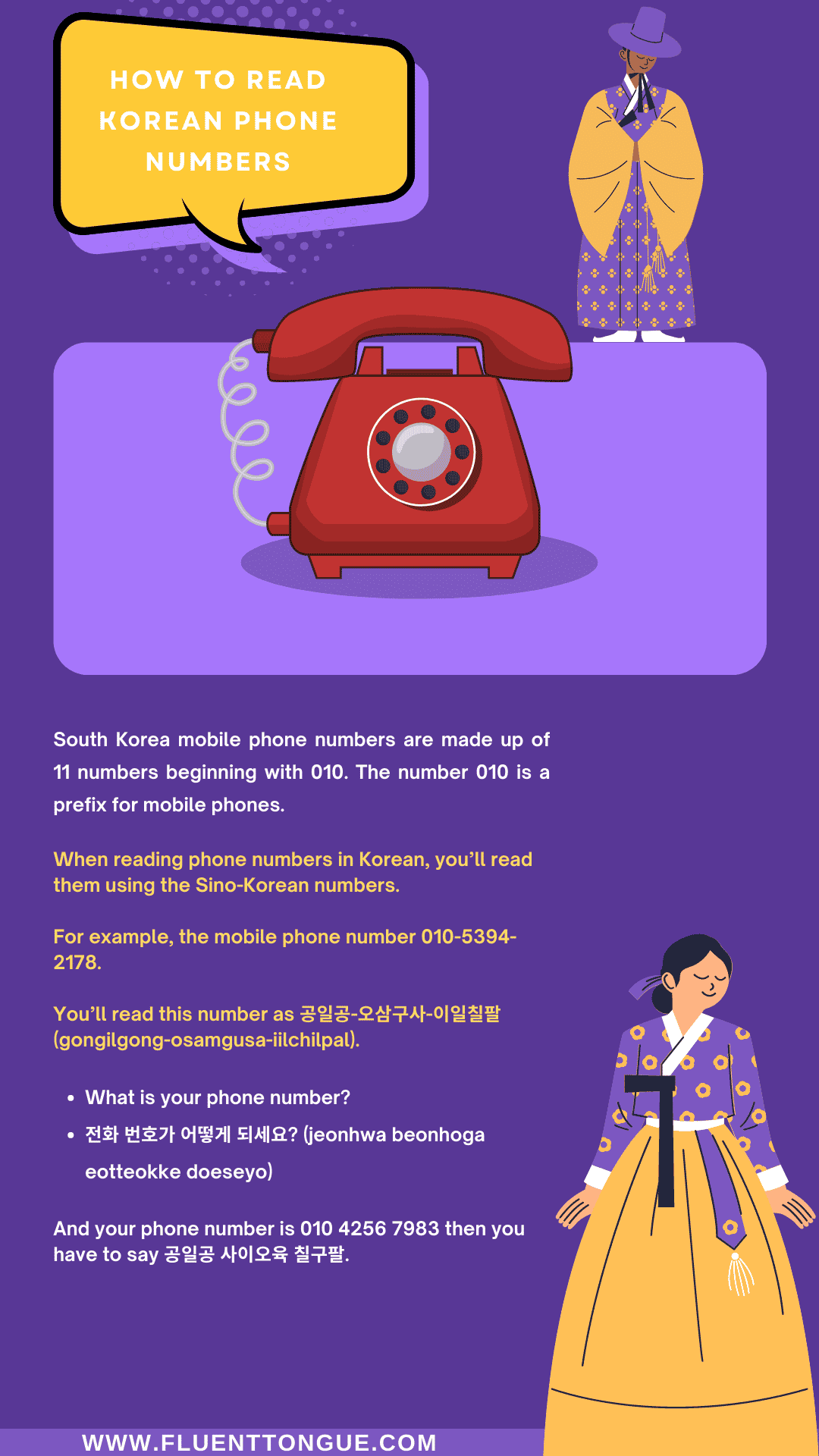
South Korea mobile phone numbers are made up of 11 numbers beginning with 010. The number 010 is a prefix for mobile phones. If you’re going to call a mobile phone number in South Korea, you’ll need to add the country code +82.
To say your phone number in Korean, use the Sino Korean numbers after the 010 or area code. When saying phone numbers, people will usually use 공 instead of 영 for the number zero.
For example, when someone asks you “what is your phone number?, You can say like
What is your phone number?
전화번호 뭐예요?
And your phone number is 010 4256 7983 then you can answer like to say
My number is 010 4256 7983
공일공 사이오육 칠구팔.
Another example is the telephone number +82 (2) 8765-4213.
You’ll read this as 팔이-이-팔칠육오-사이일삼 (pali-i-palchilyuko-saiilsam)
락처 좀 주시죠?
How To Learn Sino Korean Numbers Fast and Never Forget It?
Now that you have the basics down, it’s time for some practice.
Here is a list of websites I used when I was learning Korean numbers
And it might help you too. Be sure to check it out.
Anki Isn’t The Only Game In Town. just sing a song
Did you know you can sing a song and master the native Korean numbers?
Well, what could be better than that?
Here is how Koreans do it all the time (now you can do it too!!!)
if learning Korean number songs doesn’t suit you,
How about some k drama or miniseries?
Learn Korean numbers using Korean drama/ mini-series
It’s no secret that the more you use words in real life, the quicker you memorize these piles of Korean words without lifting a finger.
So, why not try it now?
Don’t know how to?
Here is a funny video I got while I was learning Korean numbers (funny but effective)
How to Count with sino Korean Numbers | TEUIDA Mini-Series
Counting Sino-Korean Numbers | TEUIDA Mini Series
Here is a funny video on I got while I was learning Korean numbers (funny but effective) by TEUIDA Mini Series.
Use flashcards and Test
Maybe mnemonics is not your thing. What about flashcards?
I know it’s an old thing(you might be using Anki too)
But When it comes to mastering Korean vocabulary, you will never regret using these fellas.
Here are some other great resources for flashcards I found while I was learning Korean online
https://www.cram.com/flashcards/sino-Korean-numbers-3251464
https://app.memrise.com/course/370118/learn-Korean-numbers/25/
https://quizlet.com/35019815/sino-Korean-numbers-flash-cards/
https://memorang.com/flashcards/1381661/native-Korean-numbers
https://quizlet.com/203672998/native-Korean-numbers-31-40-flash-cards/
Other Online Resources
We live in the era of the 20th century.
And I bet you love to surf (well, who doesn’t?)
The internet is full of free stuff and language resources that you haven’t explored yet. Here is what I found when I was learning.
Here is a list (I hope it might help you)

https://www.wikihow.com/Count-to-10-in-Korean
https://www.Koreanwikiproject.com/wiki/Sino_Korean_numbers
https://www.margaritaKorean.com/single-post/2015/09/10/Weekly-Korean-Episode-4-SinoKorean-Numbers
https://www.wattpad.com/450441489-Korean-basic-words-hangul%2Btrans-numbers-sino
Conclusion and Korean Numbers Practice
Yay! You did it. Congrats on mastering those difficult Korean numbers.
Let me tell you a little secret about numbers in Korean language.
But here is the thing
When the average Korean speaker uses them in conversation, they feel nothing.
It’s fine, though.
In order to master numbers, it’s not about how they’re spelled or why so many math/ two Korean number systems are involved. It’s about memorizing and most importantly, using them in real life.
You’ll be scared of these numbers for a little bit. But one day you’ll be like “I got this.” It happened to me, and it’s happened to all of my non-native Korean-speaking friends.
So, what method do you use to learn the Korean numbers in the comments below?
